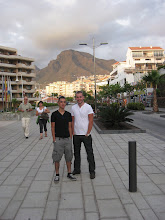Saturday, 3 April 2010
Portakabins tend to be stacked besides each other and on top of each other. Therefore I decided to use that fact in my designs, I decided to cut out a rectangle in the top right of the red block of the logo (below) to resemble a 'kabin'. Using flash I produced a moving animation showing the 'kabin' lowering into the red block, to then create what looked like a 'kabin' (the initial red block) once it connected into place. The type would then appear once this movement had taken place.
Description of a Portakabin
A portable building, or demountable building, is a building designed and built to be movable rather than permanently located. A common modern design is sometimes called a modular building, but portable buildings can be different in that they are more often used temporarily and taken away later. Portable buildings (e.g. yurts) have been used since prehistoric times.
The most familiar modern type of portable buildings are designed so that one can be carried to or from site on a large lorry and slung on and off by a crane.
Portable modular buildings have various uses. They are often seen, alone or in groups, as temporary site offices on building sites (where they are often stacked two high with metal stairs to reach the upper level; see also construction trailer). Other uses for these and other types of portable buildings are as guard sticks, rural offices, on-site changing rooms, etc. Some portable buildings are very complex by joining units these forming large office blocks. (even over several floors). These are often disguised as a normal building often with brick style cladding and a traditional pitched roof. Tara Park developed by Liverpool City Council have even used portable buildings to create temporary/permanent domestic housing for communities complying with UK building regulations and disable access.
Due to population increases in many areas, portable buildings are sometimes brought in to schools to provide relief from overcrowding. Portable classroom buildings often include two classrooms separated by a partition wall and a toilet.
The most familiar modern type of portable buildings are designed so that one can be carried to or from site on a large lorry and slung on and off by a crane.
Modern usage
The modern portable building, or "knock-down" building, was first developed by United States firm Porta-Kamp in 1955. The first portable building under the trade name Portakabin was built in 1961 in England. Currently the UK's number one supplier of portable buildings is Elliott Hire. Elliott Hire is a division of Elliott, which is a subsidiary of Algeco which together with Williams Scotsman is the largest supplier of portable accommodation in the world.Portable modular buildings have various uses. They are often seen, alone or in groups, as temporary site offices on building sites (where they are often stacked two high with metal stairs to reach the upper level; see also construction trailer). Other uses for these and other types of portable buildings are as guard sticks, rural offices, on-site changing rooms, etc. Some portable buildings are very complex by joining units these forming large office blocks. (even over several floors). These are often disguised as a normal building often with brick style cladding and a traditional pitched roof. Tara Park developed by Liverpool City Council have even used portable buildings to create temporary/permanent domestic housing for communities complying with UK building regulations and disable access.
Due to population increases in many areas, portable buildings are sometimes brought in to schools to provide relief from overcrowding. Portable classroom buildings often include two classrooms separated by a partition wall and a toilet.
Portakabin 'End Sting'
This is the logo I was allocated to produce an advertisement 'end sting' for. End stings are usually at the end of an advert which show the company logo in a smart and clever way. As you can see I got given the logo from the company Portakabin, which basically specialises in delivering portakabin's.
Subscribe to:
Comments (Atom)



